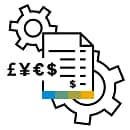Control Company Costs
Asking the Experts About…Concur Invoice
Get the heads-up on the latest features and time-saving tips
SAP Concur provides valuable insights and expert advice that could save hours for your
team—and help to optimise your organisations financial performance.
Our recent Ask an Expert: Invoice webinar was packed with useful information from Sonia
Blaudez, SAP Concur's Senior Presales Consultant, and Claire Wreford, Client Success Partner.
This on-demand session focused on some of the latest business review features available with
Concur Invoice. Sonia and Claire also explained the advantages of p-cards, the importance of
purchase orders, and how to reduce clicks and speed up processes. The live Q&A garnered
helpful extra details too.
We’ve picked out snippets from the webinar—but it's well worth watching the video in full if you
want to put into practice the new features and helpful tips we highlight.
Business reviews: Now you can dive deeper
At SAP Concur, we'd like to say big thank-you to customers who've offered great feedback and
ideas on how we can take Concur Invoice business reviews to the next level.
Over the past 18 months, we've developed new features around how you can access more
meaningful, actionable data. Here's a taste of what you can expect ...
Preventing late payment problems
Amassing old, unpaid invoices can lead to serious consequences, such as late payment fees,
calls and emails from angry suppliers, and a frosty reception next time you want a negotiate
contracts and prices.
Fortunately, the Concur Invoice business review process now lets you see clearly how many
invoices are overdue (ie. more than 30 days), via a Fast Facts box. You can then take
remediation action.
It's important to note that:
- For data to be accurate, every invoice needs a submission date and a payment date. The webinar provides advice on getting clean and consistent data
- Adding a forwarding rule in your mailbox (towards SAP Concur) for invoices arriving via email can help to expedite the process of getting them paid on time
- The system will show you how many invoices are being approved using mobile. Increasing the number of your approvers using mobile will speed up processing
- You can examine any bottlenecks in more depth if you wish. For example, you can discover if there are delays with particular suppliers or approvers. Just ask your SAP Concur representative and we'll create a report that reveals the answers
Making best use of purchase orders
Are the invoices you receive accurate—or are you paying the wrong amount? It's alarming to
note that a KPMG 2022 survey on risk management reveals that 54 percent of respondents
believe they have been over-billed by a third party at least once during the last 12 months.
When companies happen to notice this, it can lead to a lengthy exchange of emails and
documents between finance and suppliers before it's resolved. Fortunately, you can solve the
problem using purchase orders (POs) with automated two-way or three-way matching within
Concur Invoice.
Our new business reviews can show you traditional PO spend versus non-PO spend by value
across a full year (not just by percentage), so you can see if the numbers are headed in the right
direction—and push for greater PO usage if action on compliance is needed.
- The webinar provides more details, as well as a whole section on how to introduce a purchase order system at your company for the first time—with advice on how to achieve the culture change that might be required.
Now's a great time to consider p-cards
It's an uncomfortable truth, but many low-value, one-off purchases can end up costing less than
the process that authorises their payment. For example, a £20 membership subscription or a
flower bouquet may require a series of people to request supplier information, set up the new
supplier on the system, verify their bank details, and then process and approve the purchase.
However, organisations can manage low-value purchases in a simpler and more cost-effective
way using p-cards—a form of company charge card—and bring this spend into SAP Concur.
Companies can set general policies, rules and limits on p-card spending and then tailor this for
individuals, with transactions reviewed on a set schedule, usually monthly.
In the webinar, we walk you through the steps needed to get p-cards up and running in SAP
Concur. Employees can photograph and upload receipts easily, charges are auto-populated to
expense types, and statements are routed for approval.
Tips and tricks to optimise your platform
Reducing the number of clicks it takes to complete tasks will save valuable time and also boost
efficiency in invoice management. The webinar explores ways you can do this, including:
- Default expense types: If there are companies that always provide you with the same items, then there's no need to keep coding their details manually. Use automation instead and allocate a GL account to them that can be used for every invoice they submit.
- Default invoice owners: In a similar way, maybe there's someone in your team that always handles the review and accounting assignment for a specific supplier? If so, you could cut out the steps in the middle (usually completed by accounts payable) and route the invoices straight from capture to your colleague.
- Review your custom fields: Over time, some custom fields can become redundant because your business has changed, so it's worth reviewing and pruning them. You can tweak them too and save time. For example, some of the default options may now be tilting in a different direction, so leave them checked or unchecked to reflect how your business has changed. These will all help to free up people's time.
- Favourite distributions: Changes here can save an enormous amount of time, especially around accounting splits, where certain invoice payments are routinely shared between multiple cost centres at fixed percentages. Simply create a 'favourite' on the drop-down menu and select this option every time these types of invoices arrive.
The webinar offers step-by-step guides on these and other tips.
Payment requests without an invoice
Did you know, it's possible to allow some employees to request a payment when there's no
invoice? For example, this might be for something like a recurring lease payment, a one-off
transaction with a one-time supplier, or an internal payment between business units.
After logging into SAP Concur, your employee can complete an online form and attach any
relevant files. The system then checks the details and enforces controls before passing the
request to a manager for approval. This is followed by an extra step where the finance team
rubber-stamps the payment.
Throughout the process, the original requester has visibility of progress. Because of this, they
can answer any requests from the supplier about the status of payment, which saves time for
your AP team.
Discover more
For fuller details on the new business reviews, p-cards and time-saving tips, watch Ask an Expert: Invoice webinar.

